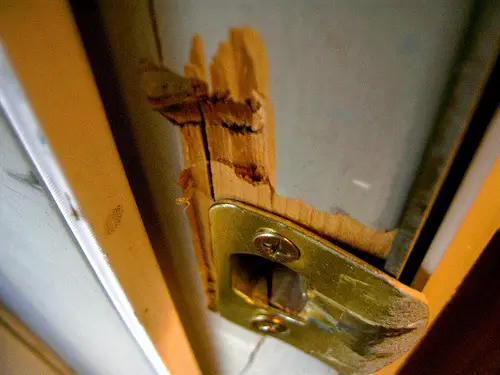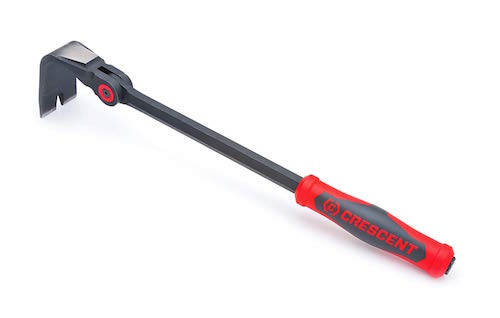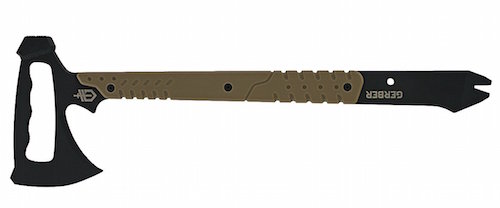There’s all sorts of tools out there for your everyday carry needs. However, the one tool most often overlooked is the pry bar. Many EDC practitioners dismiss this tool because of the limited usage. However, this very unique tool has one specialized job, but it does that job extremely well. So, why should you EDC a pry bar in your kit? The answer is simple. A pry bar is the most effective tool for whenever you need to apply leverage to pry something open or apart. Sure there are some fringe benefits, to having a pry bar on hand, but essentially you’ll use it to gain mechanical advantage.
Table of Contents
How Does A Pry Bar Work?
The anatomy of the pry bar is extremely basic. There is a tapered end that usually curves slightly (your fulcrum) which connects to a length of bar. Additionally, the length of bar is usually covered at one end with some form of non slip grip. Traditional pry bars often have a slimmer flatter profile, with notches on the end to assist with prying out nails and other construction fasteners. Don’t get me wrong, you can absolutely carry one of these if you prefer that pry bar design.
Now, onto how the pry bar actually works. When using the pry bar to open a door for instance, the frame of the door acts as the fulcrum. The tip is inserted (more like wedged) into any available space, and pressure is applied to the handle of they pry bar to create clearance for the door to open. Alternatively, the force you apply through the pry bar could actually break the locking mechanism allowing the door to swing freely.
Conversely, if you don’t have something to wedge the pry bar against (e.g. the door frame), the slight curve/bend in the length of bar acts as the fulcrum. In either scenario, the length of the bar provides you the mechanical advantage to amplify the force you exert.
Why Carry An EDC Pry Bar?
I could fabricate stories for you about all of the times that I’ve had to use a pry bar from my EDC kit. However, those stories would be just that, stories. But, I will say, that there may come a time when you need this tool to save yourself, a loved one, or a stranger. Beyond that, it’s just a handy tool to make life easier on simple tasks.
Imagine this scenario: You are driving down the road on a rainy day, and notice a bad accident. A car has hydroplaned and skidded off the road. The vehicle is upside down in a ditch. Because it’s been raining all day, the ditch is filled with water, and it’s steadily rising. There’s a person trapped inside, but they can’t get the door open. If you don’t get them out, the rising water level threatens to drown them before help arrives. What better tool to have on hand than your EDC pry bar?
EDC Pry Bar Uses
Of course the above scenario is a bit extreme, but I’m using it to illustrate a simple point. It’s best to have a pry bar and not need it, than it is to need it and not have it. Of course, there are plenty of other reasons to have a pry bar handy. Generally, there’s no other tool that can allow you to apply force of a similar magnitude to separate two objects. Even your EDC knife will likely snap at the handle (or the blade if you’re unlucky).
- Open your trunk if it’s stuck
- Pry open a car door
- Break an exposed lock (in the event of a building fire for instance)
- Open a can of paint
- Lift a heavy object (perhaps to get a dolly underneath it)
- Puncture glass, or even cinder blocks if necessary
- Rudimentary digging tool
- Rudimentary scraping tool (for glue or other adhesive)
- Nonlethal self defense tool (similar to a telescopic baton)

I’d like to take a moment and explain that this tool is seldom used for applications where a fine touch is necessary. Often times, you’ll end up damaging or destroying whatever you’re using your pry bar on. There are exceptions to this rule, but if you bust out your EDC pry bar, chances are, somethings getting broken.
Are Mini Pry Bars Effective?
Nowadays, there’s a market for mini pry bars (they should name them “micro” pry bars) . People wonder if a mini pry bar is an effective addition to their EDC kit. While this may not be a popular opinion, I personally think that most of these are a waste of money. More often than not, they serve as a glorified bottle opener. I can open a bottle of beer with a lighter, so I’m not too concerned about having a bottle opener on my carabiner key chain.
Proponents will argue that these tools often come with nifty cut outs. Arguments about “loosening bolts”, or “but there’s a screw driver built in” are the most common. That’s all well and good, but there’s a reason I carry my Leatherman multitool, which you can read more about here. Oftentimes, these same proponents neglect that the tool is a PRY BAR first, and all of the other options are secondary.
While I do think that these micro pry bars have a place in the EDC world, it certainly isn’t for prying things apart. Because these tools are often short (e.g. less than 6 inches long) it does not allow for proper leverage for any heavy duty application. When I need a tool to pry open that car door to save someone’s life, I most assuredly want a tool adequate for the job.
How To Choose Your EDC Pry Bar
Choosing the right pry bar for your EDC needs depends on a number of factors. The first of which is the primary method of carry. If the pry bar is part of your vehicle kit, then little consideration need to be given about the space you allot. However, if you’ll be carrying your EDC pry bar in your backpack, then space is definitely a factor to consider.
Furthermore, you’ll want an EDC pry bar that is a minimum of 10-12 inches long. This will allow you to provide ample force behind wedging or driving the tip of the pry bar into it’s intended location. Plus, you’ll have ample space to grip the pry bar with at the very least one hand. Additionally, it will allow for clearance of your knuckles while you grip the tool. Ideally, you’ll have a handle you can easily grip. The last thing you want is to have sweaty palms deter you from accomplishing your goal.
Best EDC Pry Bar
All of these reasons are why I recommend the Gerber Mini Pry Bar (Amazon Link). I know that it’s technically a “mini” pry bar and I just got finished trashing mini’s. However, unlike most on the market, this tool actually does the job required of a pry bar. Furthermore, it doesn’t try to be cute and add a bunch of other functions in a compact package. Instead, it says “I’ve got one job to do, and I’m gonna do that better than any other tool on the market.” Finally, because I carry a tactical backpack, I have all sorts of MOLLE webbing, and it fits nicely on the side of my EDC pack. This makes it easy to get to, it doesn’t add that much weight (a little over half a pound), and doesn’t get in my way throughout the day. All of this is offered at a reasonable price that won’t crush your wallet.
What Are Other Good EDC Pry Bar Options?
If you’re looking to outfit your kit with a proper EDC pry bar, but the Gerber Mini seems a bit limited, here are some other options. I don’t have any direct experience with these particular models, but they meet my above qualifications and have some nifty bonus features for your prying needs!

Crescent Tools 18 Inch Pry Bar
The Crescent Tools pry bar (Amazon Link), has a very unique attribute not found (at least from what I saw) on any other pry bar. Instead of having a fixed tip, you can actually change the angle of the tip. This allows you to gain leverage in different ways. So, if space is a limiting factor when prying something open, I can see the appeal of this model. I would be worried that under extreme load that the locking mechanism for the pry bar tip could fail. However, the idea is unique enough to warrant a spot. Additionally, the overall length of this pry bar is 18 inches, and is just a bit taller than my backpack, so carrying this every day could prove cumbersome and difficult. But, for a vehicle EDC kit, it could be ideal.

Gerber Downrange Tomahawk Breaching Tool
If you want tactical, this EDC pry bar has it in abundance. Plus you’ll get the added bonus of having a sweet axe for chopping and slicing. However, for the price, I don’t think the Gerber Downrange Tomahawk Breaching Tool (on Amazon) is worth it. But that’s really for you to decide, since it meets our ideal criteria from above.
Like the Crescent Tools pry bar, this bad boy runs a bit on the large side. Alternatively, the axe is cutout with a grip to give you added leverage because now you have adequate space to use both hands for prying power. Furthermore, this tool is a bit on the heavy side, weighing in at almost 2 lbs! Of course, this generally means it is durable, but I try to conserve as much weight as possible on my kit. Although, if you’re a real hoss, then give this a shot and let people know your thoughts in the comments below!
Parting Shots
While it is certainly one of the most overlooked pieces of your kit, an EDC pry bar should be considered essential. Although the limited usage would make it seem like an obsolete inclusion, there’s really no other tool that can take it’s place. Finding a spot in your EDC kit may take some careful consideration, but having this in your kit could mean a world of difference. When you need it, you’ll be happy you had it.








